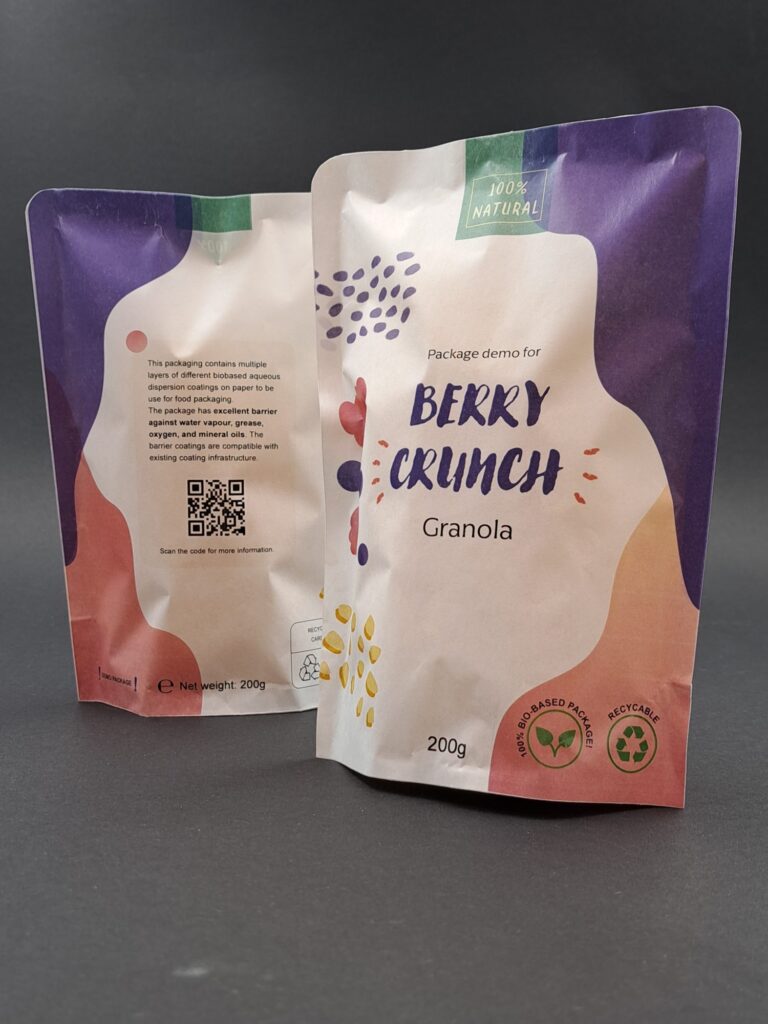The article was written by Ulla Forsström from VTT and originally published in Open Access Government.
Principal Scientist Ulla Forsström from the VTT Technical Research Centre of Finland Ltd tells us about the INN-PRESSME Open Innovation Test Bed project, which aims to develop novel, sustainable and recyclable bio-based solutions to replace fossil-based plastic
The European Commission’s proposal for a ‘Revision of the Packaging and Packaging Waste Directive’ sets high targets for recycling packaging waste.
Responsible retailers and consumers across Europe are needed to achieve these targets set for the circular economy model. This involves reusing packages as products or reusing materials for manufacturing new products. The regulation’s target is for all packaging to be recyclable by design by 2030 and for manufacturers to ensure their packaging will be recyclable ‘at scale’ by 2035.
Plastic packaging recycling is not yet at the same level as paper, metals and glass
Recycling fibre-based packaging has been common for decades in all European countries, and the average recycling rate of all paper grades has been over 70% for several years.
The recycling and reuse of plastic packaging is growing slowly, but huge challenges remain, and a lot of plastics are still leaking into our environment.
Most of the plastic in our oceans comes from land, meaning that collection and reuse not only nationally but internationally are needed to create a real circular economy.
Reusing plastics as products, plus recycling and reusing materials again, are complementary solutions to achieve circularity.
However, recycling plastic packaging is not yet at the same level as paper, metals, and glass, and therefore, future recycled content targets will be applied in the production of plastic packages to improve the circularity of plastic materials.
The European Green Deal provides a roadmap and an ambitious catalogue of measures for creating a sustainable and green European economy with net-zero emissions by 2050.

The future of bio-based solutions as alternatives to fossil-based counterparts is growing
The latter provides ‘a future-oriented agenda for achieving a cleaner and competitive Europe in co-creation with economic actors, consumers, citizens and civil society organisations.’
Europe is currently still very dependent on fossil-based raw materials. The use of bio-based solutions as sustainable alternatives to fossil-based counterparts is growing in various industries, including packaging, transport, and consumer goods.
The main aim of the INN-PRESSME Open Innovation Test Bed project is to develop novel, sustainable and recyclable solutions based on bioplastic or create fibre-based alternatives that can be recycled with other fibre-based materials.
After the project, the pilot lines and other services of the INN-PRESSME OITB can be bought by start-ups, SMEs, and large industrial companies as commercial services to develop and scale up their bio-based sustainable alternatives. As we enter the final year of the INN-PRESSME OITB, the communication about the results of demonstrated solutions based on biomaterials and technologies used in these applications has started.
One example of a recyclable packaging solution is a fibre-based flexible barrier packaging for dry and greasy food. It was developed by using novel water-based biomaterials and multilayer dispersion coating technologies.
Traditional dispersion coating technologies, commonly used in paper conversion, were used to apply the different layers. The multilayer coating in pilot scale is based on using a three-layer solution.
The water-based thermoplastic polylactic acid dispersions are coated as the first and last layers on fibre-based substrates to give water vapour and grease barrier properties and heat sealability for the packaging material. As a middle layer, a hybrid material-based lacquer bio-ORMOCER® improves oxygen barrier properties.
The developed bio-ORMOCER® has a high crosslinking between biocomponents and inorganic particles, creating a dense structure needed for oxygen barrier performance. This multilayer packaging pouch material showed promising results in the recyclability testing. The final convertibility testing of the developed packaging material is arranged by INN- PRESSME project’s industrial partner.
Two different packaging designs are produced for final testing as sealed pouches, which are ongoing. The preliminary targeted design for a multilayer-coated flexible pouch is shown in the figure above.
Biodegrable solutions in other consumer products to replace oil-based plastic
The second example is a personalised biodegradable 3D-printed shoe sole. The use of natural fibres in developing new plastic composites is growing, and these fibres can improve the mechanical performance of the composites.
Natural fibres are from renewable resources, are relatively low-cost, and have specific strength and stiffness.
The fibres used underwent several chemical and mechanical treatments before being mixed with biopolymers. The mechanical tests executed for injection moulding and 3D printing showed the effect of the type and amounts of added fibres on a polymer matrix with both fabrication processes.
3D printing makes it possible to obtain composite samples by an alternative method to injection moulding. It is a novel alternative that allows versatility, customisation, affordability, and rapid production of different parts. Optimised formulations made of biopolymers with flax or hemp fibres were studied to produce filaments that were then used for 3D printing the final demonstrators.
Four different sizes of inner shoe soles were made using 3D printing technology (Figure 2), each with its corresponding left and right soles. Eight soles were printed with the project material to carry out the necessary tests. The softness and other required characteristics targeted were achieved, and the INN-PRESSME industrial partner continues with the final tests to evaluate the prototypes with real end-users.
In addition to these examples, several other bio-based end-products are demonstrated and disseminated during the project term.